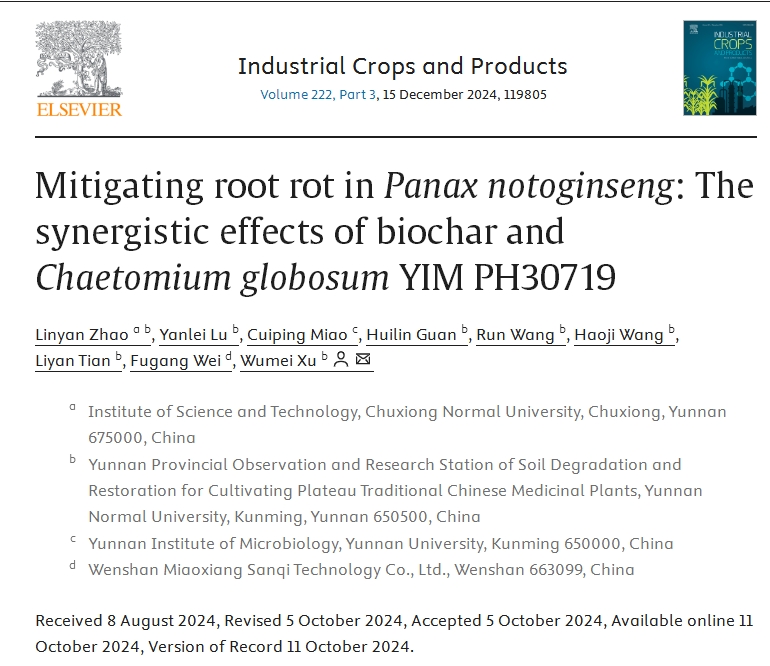博文
云师大能环学院徐武美教授课题组在知名期刊《Industrial Crops and Products》上发表最新研究成果
||
2024年10月9日,Elsevier 旗下top期刊《Industrial Crops and Products》在线发表了云南师范大学能源与环境科学学院徐武美教授课题组最新研究成果《Mitigating root rot in Panax notoginseng: The synergistic effects of biochar and Chaetomium globosum YIM PH30719》。云南师范大学能源与环境科学学院徐武美教授为通讯作者。
https://www.sciencedirect.com/science/article/abs/pii/S0926669024017825

Abstract
Root rot is the main soilborne disease that causes the replant failure of Panax notoginseng, a famous medicinal plant in Asia. Biochar and biocontrol agents have been shown to reduce replant failure separately; however, a knowledge gap still exists regarding the effectiveness and mechanisms of their combined application on the root rot incidence of P. notoginseng. In this study, we conducted a pot experiment using a randomized block design, biochar derived from tobacco stems was applied at 0, 1, 2, and 3 % (T0, T1, T2, T3) to the soil that cultivating P. notoginseng for 10 years continuously; moreover, Chaetomium globosum YIM PH30719, a newly screened biocontrol strain, was applied at 0, 1.0×107, and 1.0×1010 cfu·mL−1 (C0, C1, C2) to the soil. Six months post-transplantation of P. notoginseng seedlings, root rot incidence, soil physicochemical properties, fungal communities, and abundance of the primary pathogen Fusarium oxysporum were investigated. The results showed that, comparing with the single application of YIM PH30719, the combined application with biochar was more efficient in reducing the root rot incidence (P<0.05). P. notoginseng experienced a root rot incidence of 65.4 % under the T0+C0 treatment, however, under T3+C2 treatment, the root rot incidence was only 5.6 % (P<0.05). The reduction in root rot incidence might be linked to changes in soil pH, organic matter, and essential nutrient contents, as well as the increased soil fungal diversity and the relative abundance (RA) of beneficial Chaetomium and Trichoderma, and the decreased RA of pathogenic Fusarium and Alternaria. Consequently, the joint use of biochar and biocontrol agents (YIM PH30719) synergistically decreased the occurrence of root rot by modifying soil physicochemical characteristics and fungal communities. Since root rot is commonly found in agriculture, the results of this study may help in controlling root rot disease in other crops.
扩展阅读:
徐武美-云南师范大学能源与环境科学学院https://blog.sciencenet.cn/blog-454141-1455971.html
上一篇:云师大物电学院欧全宏、汤俊琪在硅酸盐top期刊《Ceramics International》发表最新研究成果
下一篇:云南师范大学招聘开始了,30个教学科研岗位虚位以待您的加盟!